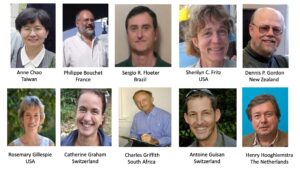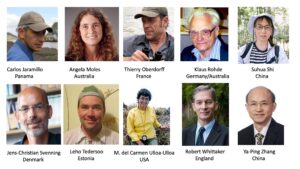TIBS Distinguished Fellow Award


*Note: geographic affiliations are self-identified by awardees
The International Biogeography Society is pleased to announce its newly selected Distinguished Fellows of 2022!
Fellows are chosen based on their outstanding contributions to the mission of our scientific society through excellence in basic research and exceptional service to the field of biogeography. Biogeographers use data and approaches from many disciplines within the physical and natural sciences, and by analysing how species and environments interact, biogeography provides a scientific basis for predicting future range changes and contributes insights to conservation biology. community ecology, and species diversity.
The Distinguished Fellow award is a senior career award to people who have made an important contribution over time. Thus, nominees will normally have been engaged in the profession for 10 years or more, and will have engaged with the International Biogeography Society (as a member or meeting attendee) for a year or more.
Please read more about, and join us in congratulating the following selected individuals for the 2022 TIBS Distinguished Fellow Award:
Dr. Chao (Taiwan) uses statistical, mathematical, and ecological approaches to understand the species richness and dissimilarity of different geographic regions. She is especially well-known for her work on mark-recapture methods for estimating the size and diversity of populations.
Dr. Bouchet’s (France) work focuses on mollusc species richness in complex tropical coastal environments, addressing issues such as rarity, spatial heterogeneity and endemism. He has authored major taxonomic monographs, described over 600 new species of molluscs, led the publication of online taxonomic datasets (World Register of Marine Species, MolluscBase), and led teams of experts on numerous intensive field expeditions that have discovered thousands of new species.
Dr. Floeter (Brazil) works on marine biogeography and macroecology, including the evolution and trophic structure of reef fishes. He has led interdisciplinary fieldwork expeditions and conducted large scale data analyses to understand why and when the areas of fish endemism of the tropical Atlantic Ocean were formed, how they relate to each other, and what processes have contributed to faunal enrichment.
Dr. Fritz‘s (USA) interests lie at the interface of geological, ecological, and atmospheric sciences, and focus specifically on the interaction of lakes with the atmosphere and the land surface, both in contemporary times and during the Quaternary, which shape distributions of the current biodiversity.
Dennis Gordon (New Zealand) is a global authority on the systematics, phylogeny, and biology of living and fossil bryozoans. He serves on the international project teams of the Catalogue of Life and World Register of Marine Species and is a coordinator and editor of the decade-long project “Inventory of New Zealand Biodiversity” that provides the authoritative names for the New Zealand Organisms Register.
Dr. Gillespie’s (USA) research focuses on insects and spiders, especially the elucidation and conservation of their diversity. Her contributions over many years to the field of biogeography, and to the International Biogeography Society specifically, have been outstanding.
Dr. Graham (Switzerland) is best known for her work on the role of plant-hummingbird interactions in the generation and maintenance of high tropical geographic and species diversity. She also works on drivers of global diversity and, most recently, of European montane plants.
Dr. Griffith’s (South Africa) main research interests are the documentation of marine biodiversity and biogeography in southern Africa, including the impacts of marine alien species. He is the author of eight guide books to the South African fauna, including ‘Two Oceans – a Guide to the Marine Life of South Africa’, ‘Field Guide to the Insects of South Africa’, and ‘Freshwater Life.’
Dr. Guisan (Switzerland) has focused on spatially predictive modelling of plant and animal distributions, and the communities they form. Besides theoretical and methodological interests in understanding and predicting species distributions, he has developed models for various applied purposes, such as rare species management, assessing the potential impact of climate change on biodiversity, and anticipating biological invasions.
Dr. Hooghiemstra’s (The Netherlands) contributions focus on the Quaternary history of northern South America, especially the Pliocene-Pleistocene pollen record of the Sabana de Bogota, which provide a long record to reconstruct the climate of the Northern Andes. For the tropics, the presence of these deep cores has made the Northern Andes a key area in developing and testing hypotheses in the fields of ecology, paleobiogeography, and climate change.
Dr. Jaramillo (Panama) uses the fossil record from both plants and animals to reconstruct the deep-time history of tropical ecosystems. Particular foci have been the formation of the Panama land bridge between North and South America, and the coal mines in Cerrejón, Colombia, which preserve tropical rainforest, snakes, and crocodiles from about 60 million years ago.
Dr. Moles (Australia) focuses on rapid evolution, introduced species, and the responses of Australian plants to climate change. Her primary research goal is to quantify plant ecological strategies and how they vary in space. She has also contributed to the emerging subdiscipline of functional biogeography.
Dr. Oberdorff’s (France) research focuses on the role of spatial scales in the turnover of freshwater fish communities. He has also examined the consequences of anthropogenic effects, including climate change, on the structure and function of these communities.
Dr. Rhode (Germany) is a parasitologists who for much of his career has worked in Australia. He focuses on marine parasitology, evolutionary ecology and zoogeography, and the phylogeny and ultrastructure of lower invertebrates.
Dr. Shi (China) uses genomic approaches to study the biogeography of plants, especially the adaptive evolution and speciation of mangroves. The aim of her research is to understand the molecular basis of adaptations to this extreme habitat and the geographical mechanisms of speciation revealed by mangroves.
Dr. Svenning (Denmark) focuses on the biogeography, global change ecology, and ecological sustainability in terrestrial systems around the world. His research relies on predictive modelling, the application of informatics, and space-borne and other remote sensing technology.
Dr. Tedersoo (Estonia) studies the biogeography, diversity and ecology of fungi relying on molecular techniques, such as the universal DNA barcode for fungi, the nuclear ribosomal internal transcribed spacer region. By combining these molecular tools with bioinformatics and databases, his integrative research led to numerous breakthroughs that revolutionized our understanding of the global geography of fungi.
Dr. Ulloa’s (USA) research work focuses the plant diversity of Latin America and includes treatments on the Flora de Nicaragua, the paramos of the Northern Andes, and fundamental contributions to the World Flora Online, a global online index of all scientific names for plants. She continues to conduct field work in her native Ecuador.
Dr. Whittaker works on island biogeography, conservation biogeography, diversity theory, and macroecology. His contributions to the field of biogeography, including as a founding member of the International Biogeography Society and editor of the society’s journal and magazine, have been fundamental to the development of the field.
Dr. Zhang’s (China) research focuses on molecular evolution and genome biodiversity in higher animals. His group has collected all DNAs of almost all wild animal species (more than 3000) in China and his studies have illuminated the zoogeography of the Himalayan region and the Austronesian footprint in Mainland Southeast Asia.






